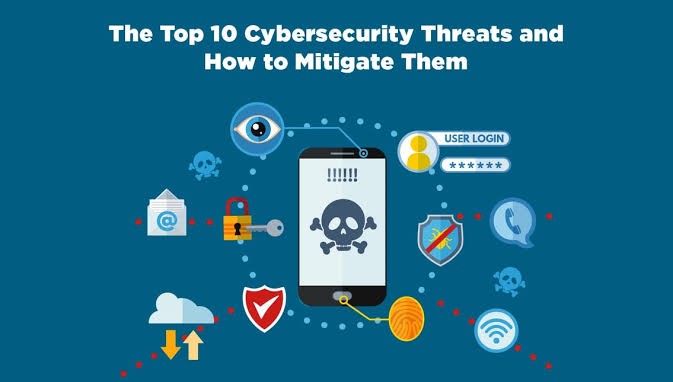What you need to know about Cyber security Threats
In the face of an exponential increase in the proliferation of ever more sophisticated actors in cyberspace with extensive and often geographically remote reach across virtually all digital strategy assets, the need for cybersecurity becomes critical.
More than ever, businesses and individuals must be attentive, informed and active to protect themselves against ever-shifting cyber dangers.
Below are the Top 10 cybersecurity threats to businesses and preventative measures to combat them:
1. Phishing Attacks:
Phishing attacks are a serious form of cybercrime; they rely on deceiving individuals into providing confidential information such as passwords, credit card numbers, and other personal information. This is commonly accomplished through fraudulent e-mails, texts, or messages which masquerade as legitimate sources, such as a bank or any popular online service. Often, the purpose of these attacks is to fool those who receive them into clicking on a link, downloading a file, or sharing information that can be exploited for nefarious goals.
When it comes to protecting yourself against phishing attacks, always remain on high alert for any unsolicited e-mails requesting personal information. Check out the following strategies to help recognize phishing scams and not become a catastrophic victim.
- Be cautious with links and attachments from unknown sources.
- Verify sender information and use two-factor authentication.
- Use anti-phishing software and keep it updated.
2. Ransomware:
Ransomware is a particularly nasty type of malware that can bring your digital life to a grinding halt. It works by encrypting your precious data, such as photos, documents, and videos, and then demanding a ransom in exchange for the decryption keys to unlock it. This malicious software can spread through various means, including phishing emails, infected software downloads, and vulnerable network connections.
To avoid falling prey to ransomware and minimize its impact, follow these essential tips:
- Regularly back up critical data.
- Use anti-virus software and keep it updated.
- Avoid suspicious links and attachments.
3. SQL Injection:
SQL injection is a sneaky attack that involves slipping malicious code into databases to gain unauthorized access to sensitive information. It's like a burglar sneaking into a house through an open window, but instead of physical theft, they're after valuable data. This type of attack can lead to disastrous consequences, including data breaches, identity theft, and financial loss.
To prevent these cyber criminals from getting their hands on your precious data, you need to take some vital precautions:
- Use prepared statements and parameterized queries.
- Limit database privileges and implement access controls.
- Regularly update software and plugins.
4. Cross-Site Scripting (XSS):
Cross-Site Scripting (XSS) is a cunning attack that involves slipping malicious code into websites, allowing hackers to pilfer sensitive user data. It's like a con artist posing as a trustworthy friend, gaining access to your personal belongings. XSS attacks can lead to devastating consequences, including identity theft, financial loss, and reputational damage.
To safeguard your website and users from these sneaky attacks, take the following essential precautions:
- Use Content Security Policy (CSP) to define trusted sources.
- Validate user input and use output encoding.
- Keep software and plugins updated.
5. Denial of Service (DoS) and Distributed Denial of Service (DDoS) Attacks:
DoS and DDoS attacks overwhelm systems with traffic, making them unavailable. To mitigate DoS and DDoS attacks:
- Use firewalls and rate limiting.
- Implement content delivery networks (CDNs) and cloud services.
- Monitor traffic and have an incident response plan.
6. Insider Threats:
Insider threats involve unauthorized access or data breaches by employees or contractors. To mitigate insider threats:
- Implement access controls and least privilege principles.
- Monitor user activity and have incident response plans.
- Conduct regular security awareness training.
7. Unpatched Vulnerabilities:
Unpatched vulnerabilities leave systems open to exploitation. To mitigate unpatched vulnerabilities:
- Regularly update software and plugins.
- Use vulnerability management tools.
- Prioritize patching critical vulnerabilities.
8. Drive-By Download Attacks:
Drive-by download attacks involve visiting compromised websites that download malware. To mitigate drive-by download attacks:
- Keep software and plugins updated.
- Use anti-virus software and a firewall.
- Avoid suspicious websites and use a web application firewall.
9. Password Attacks:
Password attacks involve guessing or cracking passwords to gain unauthorized access. To mitigate password attacks:
- Use strong, unique passwords and multi-factor authentication.
- Implement password managers and account lockout policies.
- Limit login attempts and use CAPTCHA.
10. Advanced Persistent Threats (APTs):
APTs involve sophisticated, targeted attacks to breach sensitive information. To mitigate APTs:
- Implement a defense-in-depth approach.
- Use threat intelligence and incident response plans.
- Conduct regular security assessments and penetration testing.
In conclusion, cybersecurity threats are evolving and require proactive measures to prevent and mitigate them. By understanding these top 10 cybersecurity threats and implementing effective mitigation strategies, individuals and businesses can significantly reduce the risk of falling victim to cyber attacks. Remember, cybersecurity is an ongoing effort, and staying informed and vigilant is crucial in the ever-changing digital landscape.
